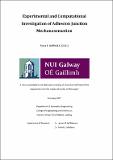| dc.description.abstract | Bone is an adaptive tissue that remodels in response to the mechanical loads placed upon it during normal daily activity. This remodelling process is vital to maintaining the mechanical integrity, mass and structure of bone throughout life and is facilitated by the cells which reside within bone, such as mesenchymal stem cells (MSCs) and bone producing osteoblasts. Both of these cell types are widely known to regulate their mechanical properties and gene expression in response to their mechanical environment, a phenomenon known as mechanosensitivity. Adhesion junctions are a class of mechanosensors, which form a direct connection between the cytoskeletons of neighboring cells, and thereby transmit forces generated by cytoskeletal contraction and can transduce mechanical stimulus into a cellular biochemical or mechanical response. The importance of adhesion junctions for mechanosensation and mechanotransduction by osteoblasts remains unclear, in particular it is not known whether adhesion junctions facilitate an osteogenic response under applied loading. The objectives of this Thesis are (a) to investigate the importance of adhesion junctions in transducing FSS stimulation into an osteogenic response in vitro, (b) computationally predicting the forces experienced at cell-cell contacts during FSS stimulation and (c) to investigate the influence of N-cadherin and OB-cadherin adhesion junctions in dictating the viscoelastic properties of MSCs.
The first study of this thesis investigates the role of adhesion junction mechanosensation in the osteogenic response of pre-osteoblast MC3T3-E1 cells to oscillatory and pulsatile FSS. The work presented in this chapter revealed that interference with adhesion junction formation prior to application of oscillatory fluid shear stress results in a significantly reduced biochemical response (PGE2, Cox-2 and Runx2), but did not significantly reduce stress fibre formation with FSS. Pulsatile fluid flow did not cause significantly higher production of PGE2, or significantly higher stress fibre formation for control samples.
The second study of this thesis investigates the mechanical response of two contacting cells subjected to FFS in a parallel plate bioreactor. To this end, A) a global computational fluid dynamics (CFD) model of the entire flow system was constructed to compute the fluid velocity and pressure in the channel region of the bioreactor, and B) fluid shear stress, pressure and cellular contractility were applied to deformable contacting cells in a local fluid structure interaction (FSI) model. Simulations revealed that oscillating FFS within the bioreactor results in alternating tensile and compressive normal contact stress at the cell-cell interface. This work presents a mechanical indication as to why cells respond differently to steady and oscillatory fluid flow regimes in parallel plate bioreactors.
Chapter six of this thesis investigates the role of N-cadherin and OB-cadherin adhesion junctions in dictating the viscoelastic material properties of MSC spheres (mesenspheres) during osteogenesis. This study demonstrated that at day 2, silencing of OB-cadherin adhesion junctions results in significantly higher instantaneous and long term Young’s moduli, viscosity and stress fibre formation in comparison to N-cadherin silenced and scrambled siRNA treated mesenspheres. Additionally, there is significantly higher viscosity, instantaneous and long term Young's moduli for scrambled siRNA treated mesenspheres between days 2 and 7, whereas this effect is not observed for either OB-cadherin or N-cadherin silenced groups. These results demonstrate that OB-cadherin and N-cadherin adhesion junctions play different roles in influencing the viscoelastic material properties of mesenchymal stem cells differently and this is likely due to their connectivity to the cytoskeleton.
Taken together, the work presented in this thesis provides a novel insight into the role of adhesion junctions in sensing and dictating the mechanical environment of osteoblasts and mesenchymal stem cells. Mechanical stimulation is vital to the maintenance of healthy bone throughout life and the results of this thesis provide an insight into the adhesion junction related mechanisms through which cells within bone sense external mechanical stimulus but also dictate their mechanical environment. | en_IE |


